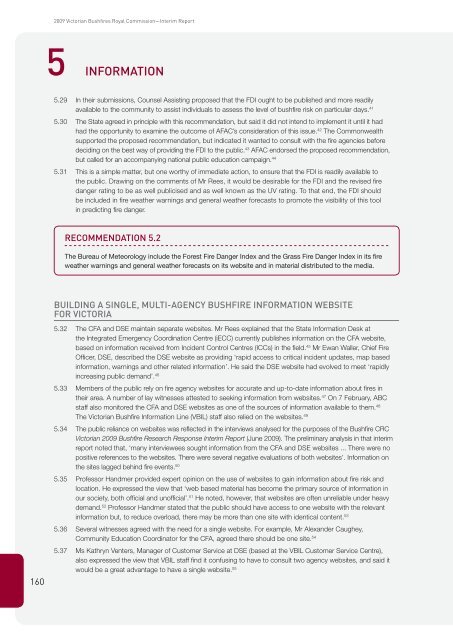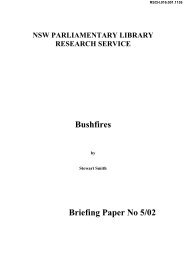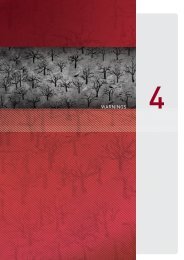Chapter 5 - Information - 2009 Victorian Bushfires Royal Commission
Chapter 5 - Information - 2009 Victorian Bushfires Royal Commission
Chapter 5 - Information - 2009 Victorian Bushfires Royal Commission
Create successful ePaper yourself
Turn your PDF publications into a flip-book with our unique Google optimized e-Paper software.
<strong>2009</strong> <strong>Victorian</strong> <strong>Bushfires</strong> <strong>Royal</strong> <strong>Commission</strong>—Interim Report<br />
5 INFORMATION<br />
5.29<br />
5.30<br />
5.31<br />
In their submissions, Counsel Assisting proposed that the FDI ought to be published and more readily<br />
available to the community to assist individuals to assess the level of bushfire risk on particular days. 41<br />
The State agreed in principle with this recommendation, but said it did not intend to implement it until it had<br />
had the opportunity to examine the outcome of AFAC’s consideration of this issue. 42 The Commonwealth<br />
supported the proposed recommendation, but indicated it wanted to consult with the fire agencies before<br />
deciding on the best way of providing the FDI to the public. 43 AFAC endorsed the proposed recommendation,<br />
but called for an accompanying national public education campaign. 44<br />
This is a simple matter, but one worthy of immediate action, to ensure that the FDI is readily available to<br />
the public. Drawing on the comments of Mr Rees, it would be desirable for the FDI and the revised fire<br />
danger rating to be as well publicised and as well known as the UV rating. To that end, the FDI should<br />
be included in fire weather warnings and general weather forecasts to promote the visibility of this tool<br />
in predicting fire danger.<br />
RECOMMENDATION 5.2<br />
The Bureau of Meteorology include the Forest Fire Danger Index and the Grass Fire Danger Index in its fire<br />
weather warnings and general weather forecasts on its website and in material distributed to the media.<br />
Building A Single, multi-agency bushfire information website<br />
for Victoria<br />
160<br />
5.32<br />
5.33<br />
5.34<br />
5.35<br />
5.36<br />
5.37<br />
The CFA and DSE maintain separate websites. Mr Rees explained that the State <strong>Information</strong> Desk at<br />
the Integrated Emergency Coordination Centre (iECC) currently publishes information on the CFA website,<br />
based on information received from Incident Control Centres (ICCs) in the field. 45 Mr Ewan Waller, Chief Fire<br />
Officer, DSE, described the DSE website as providing ‘rapid access to critical incident updates, map based<br />
information, warnings and other related information’. He said the DSE website had evolved to meet ‘rapidly<br />
increasing public demand’. 46<br />
Members of the public rely on fire agency websites for accurate and up-to-date information about fires in<br />
their area. A number of lay witnesses attested to seeking information from websites. 47 On 7 February, ABC<br />
staff also monitored the CFA and DSE websites as one of the sources of information available to them. 48<br />
The <strong>Victorian</strong> Bushfire <strong>Information</strong> Line (VBIL) staff also relied on the websites. 49<br />
The public reliance on websites was reflected in the interviews analysed for the purposes of the Bushfire CRC<br />
<strong>Victorian</strong> <strong>2009</strong> Bushfire Research Response Interim Report (June <strong>2009</strong>). The preliminary analysis in that interim<br />
report noted that, ‘many interviewees sought information from the CFA and DSE websites ... There were no<br />
positive references to the websites. There were several negative evaluations of both websites’. <strong>Information</strong> on<br />
the sites lagged behind fire events. 50<br />
Professor Handmer provided expert opinion on the use of websites to gain information about fire risk and<br />
location. He expressed the view that ‘web based material has become the primary source of information in<br />
our society, both official and unofficial’. 51 He noted, however, that websites are often unreliable under heavy<br />
demand. 52 Professor Handmer stated that the public should have access to one website with the relevant<br />
information but, to reduce overload, there may be more than one site with identical content. 53<br />
Several witnesses agreed with the need for a single website. For example, Mr Alexander Caughey,<br />
Community Education Coordinator for the CFA, agreed there should be one site. 54<br />
Ms Kathryn Venters, Manager of Customer Service at DSE (based at the VBIL Customer Service Centre),<br />
also expressed the view that VBIL staff find it confusing to have to consult two agency websites, and said it<br />
would be a great advantage to have a single website. 55
















